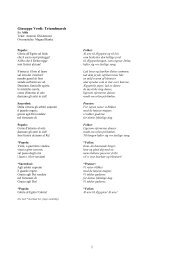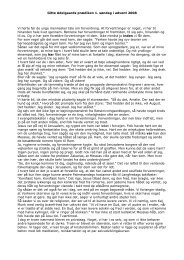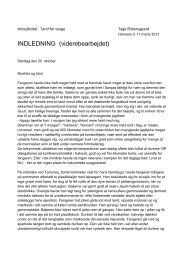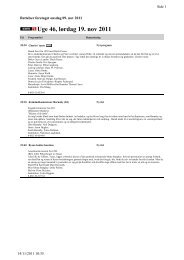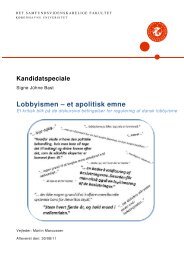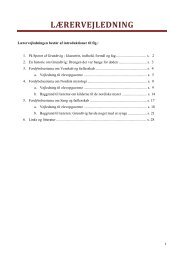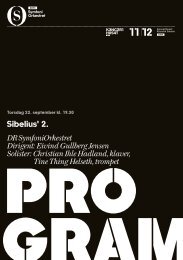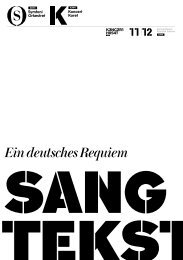Sundhedseffekter og relaterede eksterne omkostninger af ... - DR
Sundhedseffekter og relaterede eksterne omkostninger af ... - DR
Sundhedseffekter og relaterede eksterne omkostninger af ... - DR
You also want an ePaper? Increase the reach of your titles
YUMPU automatically turns print PDFs into web optimized ePapers that Google loves.
16<br />
The total external cost is about DKK 500 million in Copenhagen and Frederiksberg<br />
due to emission sources in these two municipalities in 2010. The total<br />
external costs in Copenhagen due to the total air pollution from domestic<br />
and foreign emission sources are approx. DKK 4 billion and the local emissions<br />
in Copenhagen and Frederiksberg contribute only about DKK 500 million<br />
equal to 11%. On the other hand, this means that about 89% of all external<br />
costs related to air pollution in Copenhagen are caused by emissions<br />
outside Copenhagen.<br />
If we compare the difference between external costs from the contribution of<br />
emission sources in the municipalities of Copenhagen and Frederiksberg,<br />
and Copenhagen metropolitan area, it represents approx. DDK 100 million.<br />
Consequently, the emission sources in the municipalities of Copenhagen and<br />
Frederiksberg contribute to external costs in the order of DKK 100 million<br />
outside the municipal border of Copenhagen at distances up to about 20 km.<br />
The main local source in Copenhagen that contribute to the external costs is<br />
non-industrial combustion (which consists primarily of combustion in stoves<br />
and boilers) which accounts for about 2/3 of the external costs followed by<br />
road transport (1/5). Other types of sources with a notable contribution is<br />
the use of products (emissions from solvents and use of products) with approx.<br />
5% and mobile sources (non-road mobile machinery, etc.) with approx.<br />
4%. The distribution of external costs between these sources is roughly<br />
equivalent to the distribution in the Copenhagen metropolitan area due to<br />
emission sources in Copenhagen, as demonstrated above.<br />
3.4 Uncertainties<br />
Impact pathway method<br />
The EVA-system is based on the impact pathway approach covering emissions<br />
from sources, the dispersion and chemical transformation in the atmosphere,<br />
exposure of the population, health effects, and economic valuation<br />
of these health effects. There are uncertainties in all these elements.<br />
Emission sources in Copenhagen<br />
The calculations of health effects and external costs of emissions in the municipalities<br />
of Copenhagen and Frederiksberg are based on the official national<br />
emission inventory broken down by different ge<strong>og</strong>raphical distribution<br />
keys.<br />
The main local source in Copenhagen in relation to the external costs of Copenhagen<br />
is non-industrial combustion (which consists primarily of combustion<br />
in wood stoves and boilers) which accounts for about 2/3 of the external<br />
costs. However, there is considerable uncertainty in this estimate related<br />
to the level of emissions and their ge<strong>og</strong>raphic distribution.<br />
The other main local source of emissions in Copenhagen in relation to external<br />
costs is road transport which accounts for about 1/4 of the external costs.<br />
There is less uncertainty in emissions from road tr<strong>af</strong>fic since the knowledge<br />
base and the potential for validation of emissions is much greater than for<br />
wood-burning stoves.




